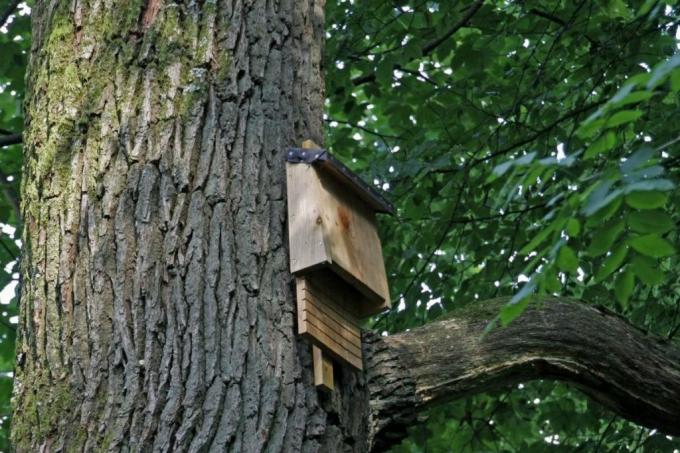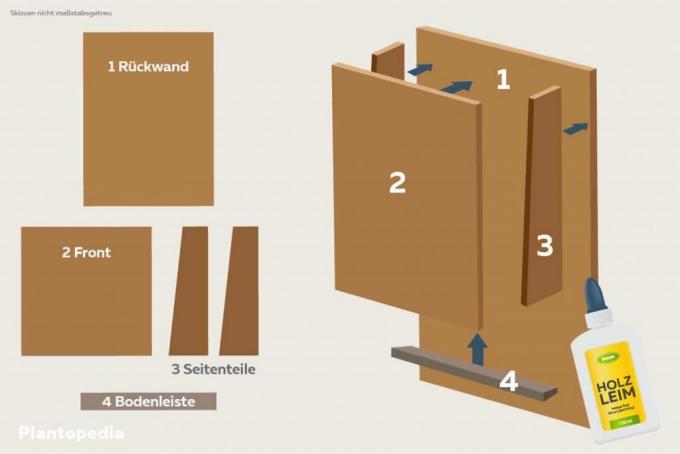
table of contents
- What is important with the bat box?
- Step by step to the bat cave
- Step 1 - the cut
- Step 2 - the body
- Step 3 - the roof
- Step 4 - Completion
- Step 5 - hang it up properly
- frequently asked Questions
The habitat more at home Bats is threatened. Trees are being cleared and buildings are being built more and more densely. It is therefore worth building bat boxes to preserve the species. We explain how it works.
In a nutshell
- Rough-sawn and untreated wood offers the animals an environment that is as natural as possible
- the right dimensions make the dwelling attractive for bats and at the same time keep birds and other "guests" away
- Built tightly and draft-free, the chances of acceptance of the dwelling are the best
What is important with the bat box?
The goal of a bat box is that the animals accept the shelter and feel comfortable there. In order to achieve this, the artificial cave has to meet some basic requirements, which also determine the later construction:
- Entry gap between 20 and 25 millimeters wide (too wide: invading birds, too narrow: no access for adults)
- tapered interior: offers animals of all sizes the possibility of stomach and back contact with cave walls (often preferred as a place to sleep)
- Draft-free construction due to dense joints, as there is a general rejection of drafty quarters
- Creation of easily "walkable" surfaces through rough sawn wood
- Avoidance of any contaminated building materials, such as varnishes, paints, glazes, etc. (high sensitivity of animals to environmental toxins)

Step by step to the bat cave
If we transfer these essential requirements to the planned nest box, the following, step-by-step, implementable instructions result.
The material
- untreated, rough sawn wood, board thickness min. 20 millimeters
- Roof battens 20 × 40 millimeters, rough sawn and untreated
- Wood glue, waterproof and solvent-free
- Roofing felt + associated roofing felt pins
- Screws + dowels for assembly, e.g. B. 6 × 100 and 3 × 40
Tip: If you plan to place the bat box outdoors, use more durable hardwood, such as beech or Oak. Boxes for more protected locations can also be built with less resistant softwood without any problems.
tool
- Table or hand-held circular saw with an inclined saw blade
- Cordless screwdriver with a suitable holder for screws
- hammer
- Screw clamps
- Pencil, ruler / set square
- Wood drill set, suitable for cordless screwdriver
Step 1 - the cut
First of all, cut the individual parts for the bat box from the wood:

- Rear wall height x width = 450 x 250 millimeters
- Front wall height x width = 350 x 250 millimeters
- Roof depth x width 110 x 310 millimeters
The tapered sides of the roof battens now follow in order to achieve the desired tapering of the box interior:
- Length 250 millimeters, thickness 20 to 40 millimeters (cut from 40 millimeter side)
Finally, you still need the floor, which you will also create from a roof batten:
- Length 210 millimeters, height approx. 20 to 30 millimeters with angled saw edge (cut from 40 millimeter side)
Step 2 - the body
Now put the body of the bat cave together and glue the individual parts over the entire surface in order to achieve an airtight joint of the individual parts:

- Glue the side parts 20 millimeter upwards to the outer edge of the rear wall
- Upper edge of the side panels flush with the upper edge of the rear wall
- by thickening the sides downwards, later widening the interior downwards
- Place the front flush with the top edge on the side panels and glue
- Glue the bottom flush with the lower edge on the inside of the cabinet lid
- let the sloping side point upwards (inside the box)
Tip: Press all glues together with the screw clamps to achieve a flat gluing without any later defects. This will avoid the unwanted drafts inside.
Step 3 - the roof
Complete the body of the bat box with a roof that you tilt slightly for better drainage of rainwater:

- Level the top of the body with a circular saw, tilting the saw blade (greater cut back on the front of the body for the roof pitch to the front)
- Put on the roof and glue it, placing the rear edge flush with the rear wall
- side and front overhang around 30 millimeters each
Step 4 - Completion
Finally, some remaining work is still missing to actually make the new dwelling ready for use:
- Screw the roof batten with the 40 millimeter side onto the rear wall
- Orientation vertical, position in the middle with the same distance to the sides
- Overhangs at the top and bottom by around 5 to 7 centimeters
- Screw connection with at least 3 screws 3 × 40 millimeters in the rear wall
- Pre-drill protrusions with a wood drill 8 millimeters for later assembly
- Cover the roof with roofing felt, fold the cardboard around the sides of the roof and nail down with roofing felt pins
- Cut off any cardboard that protrudes downwards
Step 5 - hang it up properly
The grand finale is now the hanging of your new bat box:

- align vertically
- via holes in the roof batten with the subsurface, e.g. B. House wall or tree trunk
- If necessary, pre-drill the substrate and insert dowels
frequently asked Questions
The new bat cave should offer protection from predators and the weather. The optimal location is therefore with sufficient distance to the ground and ideally not on the weather side of the house in order to avoid driving rain. Bats love warmth, so sunny locations are not a problem either. House gables or sufficiently tall trees, for example, are well suited.
The claws of bats can easily cling to natural wood. If you want to offer the animals further help, you can use the circular saw to make horizontal cuts a few millimeters deep on the back of the box before assembly.
The bat cave is designed in such a way that, for example, cats, martens or other predators cannot get inside. However, bats avoid dwellings whose access routes are heavily frequented by predators. Therefore, it is better to choose locations at a height of around 2 meters or more.



